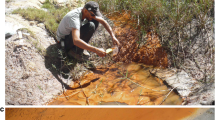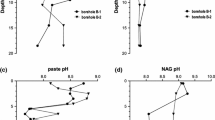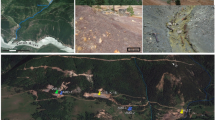Abstract
The underground extraction of Pb-Zn mineralization in the Touiref area stopped in 1958. A large volume of flotation tailings (more than 500 Mt) containing sulfides were deposited in a tailings impoundment. The goals of this study are to evaluate the neutralization capacity of the unoxidized and oxidized tailings, to assess the speciation of metals between the different components of the tailings material, and to assess the mobility of metals and the secondary minerals’ precipitation in pore waters using geochemical modeling. To accomplish these objectives, representative samples from both fresh and oxidized zones were collected along a vertical profile through the tailings pile. Physical, chemical (ICP-MS), and mineralogical characterization (X-ray diffraction (XRD), reflected light microscopy, scanning electron microscope (SEM)) of these samples was performed. Grain size analysis shows that the tailings are dominated by silt- to sand-sized fractions. The microscopic observation highlights the presence of pyrite, marcasite, galena, and sphalerite as primary minerals in a carbonated matrix. The study reveals also the presence of secondary minerals represented by cerussite, smithsonite, anglesite, and Fe oxi-hydroxides as important scavengers for trace elements. The static tests show that the presence of calcite in the tailing samples ensures acid-neutralizing capacity (ANC), which is significantly greater than the acidity potential (PA). The geochemical characterization of the unoxidized samples shows higher Cd, Pb, and Zn concentrations than the oxidized samples containing the highest values for Fe and SO4. Sequential extraction tests show that significant percentages of metals are distributed between the acid-soluble fractions (Cd, Pb, and Zn) and the reducible one (Zn). Pore water analysis indicates that Ca is the dominant cation (8,170 and 6,200 mg L−1, respectively), whereas sulfate is the principal anion (6,900 and 5,100 mg L−1, respectively). Saturation index (SI) calculations of minerals in pore water extracted from both the oxidized and unoxidized samples are indicative of gypsum (SI >0) and Fe(III) oxides (SI ≫0) precipitation. The latter controls the Fe concentration in solution.





Similar content being viewed by others
References
Adam K, Kourtis A, Gazea B, Kontopoulos A (1997) Evaluation of static tests used to predict the potential for acid drainage generation at sulfide mine sites. Trans Inst Min Metall Sect A: Min Industry 106:A1–A8
Alvarez E, Fernandez Marcos ML, Vaamonde C, Fernandez-Sanjurjo MJ (2003) Heavy metals in the dump of an abandoned mine in Galicia (NW Spain) and in the spontaneously occurring vegetation. Sci Total Environ 313(1–3):185–197
Amacher MC, Brown RW, Sidle RC, Kotuby-Amacher J (1995) Effect of mine tailings on element speciation in headwater streams. In: A. Huang et B. Bowers (eds) Metal speciation and contamination of soils. Lewis, Boca Raton, FL p 275–309
Aubertin M, Bussière B, Chapuis RP (1996) Hydraulic conductivity of homogenized tailings from hard rock mines. Can Geotech J 33:470–482
Balistrieri LS, Murray JW (1982) The adsorption of Cu, Pb, Zn and Cd on geothite from seawater. Geochim Cosmochim Acta 46:1253–1265
Banks D, Holden W, Aguilar E, Mendez C, Koller D (2002) Contaminant source characterization of the San Jose Mine, Oruro, Bolivia. In: L. Younger Paul et N.S. Robins (eds) Mine water hydrogeology and geochemistry. Geological Society of London, London, p 215–239
Benzaazoua M, Bussière B, Dagenais A-M, Archambault M (2004) Kinetic tests comparison and interpretation for prediction of the Joutel tailings acid generation potential. Environ Geol 46:1086–1101
Bethum KJ, Lockington DA et Williams DJ (1997) Acid mine drainage: comparison of laboratory testing to mine site conditions. 4th ICARD, Vancouver, B.C. 1, 305–318
Blowes DW, Ptacek CJ, Jambor JL, Weisener CG (2003) The geochemistry of acid mine drainage. In: Lollar, B.S. (ed) Environmental geochemistry, treatise on geochemistry, vol. 9. Elsevier, New York, p 149–204
Bouzahzah H (2013) Modification et amélioration des tests statiques et cinétiques pour une prédiction fiable et sécuritaire du drainage minier acide. Thèse de doctorat, Université du Québec en Abitibi-Témiscamingue (UQAT)
Bouzahzah H, Califice A, Mermillod-blondin R, Benzaazoua M, Pirard E (2008) Modal analysis of mineralogical blends using optical image analysis versus x-ray diffraction and ICP. 9th International Congress for Applied Mineralogy (ICAM), Brisbane, pp 673–679
Bouzahzah H, Benzaazoua M, Bussière B, Plante B (2014) Prediction of acid mine drainage: importance of mineralogy and the test protocols for static and kinetic tests. Mine Water Environ 33:54–65. doi:10.1007/s10230-013-0249-1
Bowell RJ, Bruce I (1995) Geochemistry of iron ochres and mine waters from Levant Mine, Cornwall. Appl Geochem 10(2):237–250
Brunauer S, Emmett PH, Teller E (1938) Adsorption of gases in multimolecular layers. J Am Chem Soc 60:309–319
Bussière B (2007) Hydrogeotechnical properties of hard rock tailings from metal mines and emerging geoenvironmental disposal approaches. Can Geotechl J 44:1019–1052
Carbone C, Dinelli CE, Marescotti P, Gasparotto G, L G G (2013) The role of AMD secondary minerals in controlling environmental pollution: Indications from bulk leaching tests. J Geochem Explor 132:188–200
Cardoso Fonseca E, Ferreira da Silva E (1998) Application of selective extraction techniques in metal-bearing phases identification: a South European case study. J Geochem Explor 61(1–3):203–212
Cardoso Fonseca E, Martin H (1986) The selective extraction of Pb and Zn in selected minerals and soil samples, application in geochemical exploration—Portugal. J Geochem Explor 26:231–248
Carlson L, Bigham JM, Schwertmann U, Kyek A, Wagner F (2002) Scavenging of As from acid mine drainage by schwertmannite and ferrihydrite: a comparison with synthetic analogues. Environ Sci Technol 36(8):1712–1719
Chakroun HK, Souissi F, Bouchardon JL, Souissi R, Moutte J, Faure O, Remon E, Abdeljaoued S (2010) Transfer and accumulation of lead, zinc, cadmium and copper in plants growing in abandoned mining-district area. Afr J Environ Sci Technol 4(10):651–659
Chakroun HK, Souissi F, Sassi-Souissi R, Bouchardon JL, Moutte J, Abdeljaoued S (2013) Heavy metals distribution and mobility in flotation tailings and agricultural soils near the abandoned Pb-Zn district of Jebel Hallouf-Sidi Bouaouane (NW TUNISIA). Carpathian J Earth Environ Sci 8(3):249–263
Chapman BM, Jones DR, Jung RE (1983) Processes controlling metal ion attenuation in acid mine drainage streams. Geochim Cosmochim Acta 47:1957–1973
Cravotta CA III (2008) Dissolved metals and associated constituents in abandoned coalmine discharges, Pennsylvania, USA. Part 2: geochemical controls on constituent concentrations. Appl Geochem 23(2):203–226
Dokoupilova P, Sracek O, Losos Z (2007) Geochemical behavior and mineralogical transformations during spontaneous combustion of a coal waste pile in Oslavany, Czech Republic. Mineral Mag 71(4):443–460
Dold B, Fontbote L (2001) Element cycling and secondary mineralogy in porphyry copper tailings as a function of climate, primary mineralogy, and mineral processing. J Geochem Explor 74(1–3):3–55
Duncan DW, Walden CC (1975) Prediction of acid generation potential. Report to Water Pollution Control Directorate, Environmental Protection Service, Environment Canada, Nov. 1975, 18p
Dutrizas JE, Dinardo O (1983) The co-precipitation of copper and zinc with lead jarosite. Hydrometallurgy 11:61–78
Éthier MP (2011) Évaluation du comportement géochimique en conditions normale et froides de différents stériles présents sur le site de la mine raglan. Mémoire de Maitrise en Sciences appliquées (Génie Minéral), Univ du Québec en Abitibi-Témiscamingue QC, Canada
Fanfani L, Zuddas P, Chessa A (1997) Heavy metals speciation analysis as a tool for studying mine tailings weathering. J Geochem Explor 58:241–248
Felmy AR, Griven JB, Jenne EA (1984) MINTEQ: a computer program for calculating aqueous geochemical equilibria. National Technical Information Services, Springfield
Ferreira da Silva E, Salomé FP, Almeida ML, Nunes AT, Luís FB, Markus H, de Carlos M, Sá CP, Paula T (2009) Heavy metal pollution downstream the abandoned Coval da Mó mine (Portugal) and associated effects on epilithic diatom communities. Sci Total Environ 407:5620–5636
Gäbler HE (1997) Mobility of heavy metals as a function of pH of samples from an overbank sediment profile contamined by mining activities. J Geochem Explor 58:185–194
Giere R, Sidenko NV, Lazareva EV (2003) The role of secondary minerals in controlling the migration of arsenic and metals from high-sulfide wastes (Berikul gold mine, Siberia). Appl Geochem 18:1347–1359
Gómez-Ariza J, Giradles I, Sánchez-Rodas D, Morales E (2000) Metal sequential extraction procedure optimized for heavily polluted and iron oxide rich sediments. Anal Chimica Acta 414:151–164
Heikkinen P, Raisanen M, Johnson R (2009) Geochemical characterization of seepage and drainage water quality from two sulfide mine tailings impoundments: acid mine drainage vs. neutral mine drainage. Mine Water Environ 28:30–49
Hudson-Edwards KA, Schell C, Macklin MG (1999) Mineralogy and geochemistry of alluvium contaminated by metal mining in the Rio Tinto area, southwest Spain. Appl Geoch 14(8):1015–1030
INM (Institut National de Météorologie de Tunisie) (2004) Archives des données de pluviométrie, température, évaporation, précipitation et vent de la région d’El Kef. INM, Tunis
Johnson RH, Blowes DW, Robertson WD, Jambor JL (2000) The hydrochemistry of the Nickel Rim mine tailings impoundment, Sudbury, Ontario. J Contam Hydrol 41:49–80
Jouirou M (1985) Étude géologique des massifs de l’Ouergha du Nords-Ouest du Kef. Rapports interne, O.N.M., 23p
Kheboian C, Bauer CF (1987) Accuracy of selective extraction procedures for metal speciation in model aquatic sediments. Anal Chem 59:1417–1423
Kleinmann RLP, Crerar DA, Pacelli RR (1981) Biogeochemistry of acid mine drainage and a method to control acid formation. Mining Engineering 33(3):300–305
Langmuir D (1997) Aqueous environmental geochemistry. Prentice Hall, Upper Saddle River, New Jersey, p 600
Lapakko KA (1994) Evaluation of neutralisation potential determinations for metal mine waste and a proposed alternative, paper presented at the International Land Reclamation and Mine Drainage Conference and the Third International Conference on the Abatement of Acidic Drainage, Pittsburg, PA
Lawrence RW, Scheske M (1997) A method to calculate the neutralization potential of mining wastes. Environ Geol 32(2):100–106
Lawrence RW, Wang Y (1996) Determination of neutralizing potential for acid rock drainage prediction. MEND/NEDEM report 1.16.3. Canadian Centre for Mineral and Energy Technology, Ottawa, ON, Canada
Lottermoser BG, Ashley PM (2006) Mobility and retention of trace elements in hardpan-cemented cassiterite tailings, north Queensland, Australia. Environ Geol 50:835–846
Macgregor RG, Blowes DW, Jambor JL, Robertson WD (1998) The solid-phase controls on the mobility of heavy metals at the Copper Cliff tailings area, Sudbury, Ontario, Canada. J Contam Hydrol 33:274–271
McKenzie RM (1980) The adsorption of lead and other heavy metals on oxides of manganese and iron. Aust J Soil Res 18:61–73
Meguellati N, Robbe D, Marchandise P, Astruc M (1983) A new chemical extraction procedure in the fractionation of heavy metals in sediments-nterpretation. In Proceedings of the International Conference Heavy Metals in the Environment. CEP, Edinburgh, pp 1090–1093
MEND (1989) Investigation of prediction techniques for acid mine drainage. MEND report 1.16.1a. CANMET, Ottawa. 51p
Miller SD, Jeffery JJ, Wong JWC (1991) Use and misuse of the acid base account for “AMD” prediction. Proceedings of the Second International Conference on the Abatement of Acidic Drainage. Montreal. Canada 3:489–506
Moran RE, Wentz DA (1974) Trace element content of a stream affected by metal mine drainage, Bonanza, Colorado. International symposium on water-rock interaction, Prague, p 22
Morin KA, Hutt NM (1997) Environmental geochemistry of minesite drainage: practical theory and case studies. MDAG, Vancouver
Nicholson RV (2004) Overview of neutral pH drainage and its mitigation: results of a MEND study. Proceedings of the MEND Ontario workshop, Sudbury
Nordstrom DK (1982) Aqueous pyrite oxidation and the consequent formation of secondary iron minerals. In: Kittrick JA, Fanning DS, Hossner LR (eds) Acid sulfate weathering, vol 10. Soil Science Society of America, Madison, pp 37–56
Nordstrom DK, Alpers CN, Ptacek CJ, Blowes DW (2000) Negative pH and extremely acidic mine waters from Iron Mountain, California. Environ Sci Tech 34(2):254–258
Ohlander B, Müller B, Axelssoac M, Alakangas L (2007) An attempt to use LA-ICP-SMS to quantify enrichment of trace elements on pyrite surfaces in oxidizing mine tailings. J Geochem Explor. doi:10.1016/j.gexplo.2006.06.001
Othmani MA (2006) Les résidus miniers de Touiref et impact sur l’environnement Mastère des Ressource Minérales: Exploration et Valorisation, Université de Tunis El Manar, Faculté des Sciences de Tunis, Département de Géologie, 91 p
Othmani M, Souissi F, Ben Mammou A, Mansouri A, Souissi R, Abdellaoui M (2006) Impact des résidus miniers sur l’environnement: cas du district minier de Touiref (nord-ouest de la Tunisie). Actes du Séminaire International sur les Géosciences au Service du Développement Durable. Tébesse, pp. 229–233
Othmani M, Souissi F, Souissi R, Mansouri A, Jrad A, Naouali H, Ben Mammou A (2007) Les résidus miniers de Touiref: caractérisation et impact sur l’environnement. Revue Méditerranéenne de l’Environnement 2:313–327
Othmani MA, Souissi F, Benzaazoua M, Bouzahzah H, Bussiere B, Mansouri A (2013) The Geochemical Behaviour of Mine Tailings from the Touiref Pb–Zn District in Tunisia in Weathering Cells Leaching Tests. Mine Water Environ. doi:10.1007/s10230-012-0210-8
Paktunc, A.D., Leaver, M., Salley, J., Wilson, J., 2001. A new standard material for acid base accounting tests. In: Proceedings of securing the future, international conference mining and the environment, Skelleftea, Sweden, pp. 644–652
Pettit CM, Scharer JM, Chambers DB, Halbert BE, Kirkaldy JL, Bolduc L (1999) Neutral mine drainage. In: Proceedings of Sudbury, 1999 Mining and environment, p 829–838
Plante B, Benzaazoua M, Bussière B (2010a) Kinetic testing and sorption studies by modified weathering cells to characterize the potential to generate contaminated neutral drainage. Mine Water Environ 30:22–37
Plante B, Benzaazoua M, et Bussière B (2010b). Predicting geochemical behaviour of waste rock with low acid generating potential using laboratory kinetic tests. Mine Water Environ 1–20
Plante B, Bussière B, Benzaazoua M (2012) Static tests response on 5 Canadian hard rock mine tailings with low net acid-generating potentials. J Geochem Explor 114:57–69
Prieto G (1998) Geochemistry of heavy metals derived from gold-bearing sulfide minerals in the Marmato District (Colombia). J Geochem Explor 64(1–3):215–222
Quevauviller P, Rauret G, Muntuau H, Am U, Rubio R, López-Sánchez JF, Fielder HD, Griepink B (1994) Evaluation of sequential extraction procedure for the determination of extractable trace metal contents in sediments. Fresen J Anall Chem 349:808–814
Rapin F, Forstner U (1983) Sequential leaching techniques for particulate metal speciation: the selectivity of various extractants. In: Proceedings of the 4th international conference on heavy metals in the environment, 2. Heidelberg, Germany, p 1074–1077
Raudsepp M, Pani A (2003) Raudsepp, M. and E. Pani (2003) Application of Rietveld analysis to environmental mineralogy. In: J L Jambor, D W Blowes and A I M Ritchie (eds) Environmental aspects of mine wastes. Mineralogical Association of Canada, Nepean, Ontario
Ribeta I, Ptacek CJ, Blowes DW, Jambor JL (1995) The potential for metal release by reductive dissolution of weathered mine tailings. J Contam Hydrol 17:239–273
Romero FM, Armienta MA, Ganzalez-Hernandez G (2007) Solid-phase control on the mobility of potentially toxic elements in an abandoned lead/Zinc mine tailings impoundment. Applied Geochem 22:109–127
Roussel C, Néel C, Bril H (2000) Minerals controlling arsenic and lead in an abandoned gold mine tailings. Sci Total Environ 263:209–219
Rouvier H (1977) Géologie de l’extrême Nord tunisien: tectoniques et paléogéographies superposées à l’extrémité orientale de la chaîne maghrébine, Thèse Doctorat ès Sci. Univ. P et M, Curie, Paris, France
Sainfeld P (1952) Les gîtes plombo-zincifères de la Tunisie. Ann. Mines et Géologie, Tunis, 285p
SERMI (1965) Inventaire géologique et minier: Étude géologique et minière de la zone de Touiref – Rapport interne, 120 p
Sharifi R, Farid Moore F, Keshavarzi B (2013) Geochemical behavior and speciation modeling of rare earth elements in acid drainages at Sarcheshmeh porphyry copper deposit, Kerman Province, Iran. Chemie der Erde - Geochemistry 73:509–517
Sobek AA, Schuller WA, Freeman JR et Smith RM (1978) Field and laboratory methods applicable to overburdens and minesoil. EPA report no. EPA-600/2-78-054 p.47-50
Souissi R, Souissi F, Chakroun HK, Bouchardon JL (2013) Mineralogical and geochemical characterization of mine tailings and Pb, Zn, and Cd mobility in a carbonate setting (Northern Tunisia). Mine Water Environ 32:16–27
SRK 1991. Guide technique préliminaire sur le drainage rocheux acide. (une traduction de “Draft Acid Rock Drainage Technical Guide” (1989) BCAMD Task Force), vol I et II. Centre de Recherches Minérales, Québec
Tessier A, Campbell PGC, Bisson M (1979) Sequential extraction procedure for the speciation of particulate trace metals. Anal Chem 51(7):844–851
Walder IF, Chávez WX (1995) Mineralogical and geochemical behavior of mill tailing material produced from lead-zinc skarn mineralization, Hanover, Grant County, New Mexico. Environ Geol 26:1–18
Acknowledgments
This work was supported by the Tunisian Ministry of High Education and Scientific Research and the URSTM of the University of Quebec, Rouyn-Noranda, Canada. We are indebted to Mathieu Villeneuve, Benoit Plante, Erol Yilmaz, and Alain Perreault for their assistance and willingness to perform the experiments and analyses. We also thank Abbdelbaki Mansouri and Mohamed Jouirou from the Office National des Mines and Mohamed Ali Fedaoui and Fethi Ouerghi from the municipality of Touiref for their technical support. Our gratitude goes to the anonymous reviewers for their comments, which greatly improved the quality of the manuscript.
Author information
Authors and Affiliations
Corresponding author
Additional information
Responsible editor: Stuart Simpson
Rights and permissions
About this article
Cite this article
Othmani, M.A., Souissi, F., Bouzahzah, H. et al. The flotation tailings of the former Pb-Zn mine of Touiref (NW Tunisia): mineralogy, mine drainage prediction, base-metal speciation assessment and geochemical modeling. Environ Sci Pollut Res 22, 2877–2890 (2015). https://doi.org/10.1007/s11356-014-3569-1
Received:
Accepted:
Published:
Issue Date:
DOI: https://doi.org/10.1007/s11356-014-3569-1




